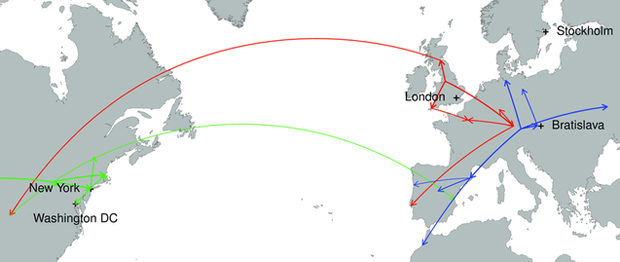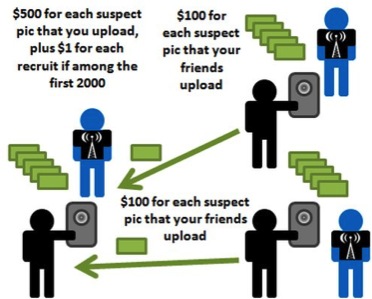
Using Social Media to Catch a Thief on March 31
Network of spotters to track ‘jewel heist suspects’ in five cities across North America and Europe
By:
- Bader Al Zarei
- Ioana Patringenaru
Published Date
By:
- Bader Al Zarei
- Ioana Patringenaru
Share This:
Article Content

CrowdScanner team logo
A group of crowdsourcing experts, including Manuel Cebrian, a computer science researcher at the University of California, San Diego, are building a team to participate in a, perhaps, impossible worldwide gaming challenge: track down five ‘suspects’ of a jewel heist in five different cities on two different continents within 12 hours. You can play, and make money, even if you don't live there.
The 'Tag Challenge' takes place March 31 and aims to determine whether and how social media can be used to accomplish a realistic, time-sensitive, international law enforcement goal. With a $5,000 reward, the winning strategy will involve building a network of spotters and teammates for the simulated law enforcement search through social media in five cities: Washington, D.C., New York City, London, Stockholm and Bratislava in Slovakia. Sponsored by the U.S. Department of State and the U.S. Embassy in Prague, the challenge has been created by an international group of graduate students from six countries.
The organizers will post on the website a “mug shot” of each suspect on the day of the event. Each suspect will be wearing a shirt bearing the event logo. The suspect’s face, dress and the contest logo will be clearly visible in each of the mug shots. Contestants may use only this photograph and any other information provided on the event website to identify each suspect and take their picture. The photos will be verified through a unique code phrase on both the front and back of the shirt, which is not revealed in a suspect’s mug shot but known only to the organizers. Participants need to make sure that the code phrase is clearly visible in each submission.

Map showing how we expect people to recruit
In order to win, a participant or team must be the first to successfully locate and photograph all ‘volunteer suspects’ and submit verifiable photographs to the contest organizers. The enormity of the challenge means that no single person or group of friends can tackle it on their own. Instead, winning is likely to rely on the ability to assemble a very large, ad-hoc team of spotters. A group of crowdsourcing and social media experts are providing the tool to do just that.
“Tag Challenge is a competition to gauge how social media can be effectively tapped to locate ‘real life’ culprits,” said the team leader, Iyad Rahwan of Masdar Institute of Science and Technology in Abu Dhabi. “We are developing a website that will enable more people to use social networks and inform their friends about the challenge and try to find the targets. We are confident that, with talented spotters, our team will emerge winners in this competition.”
The team being assembled has been dubbed “CrowdScanner” and anyone can join by visiting (http://crowdscanner.net). The site is being built in collaboration with experts from the University of Southampton and UC San Diego.

Explanation of rewards scheme
“We will give the entire reward to the participants who will actually do the work; we will keep nothing,” said Cebrian, winner of the now-famous DARPA Red Balloon challenge; a member of the CrowdScanner team; and a computer scientist at the Jacobs School of Engineering at UC San Diego.
If you submit a photograph of a target to CrowdScanner and team wins, you will receive $500. In addition, if you invite a friend, and your friend submits a winning photograph, they get $500, but you also get $100. To help spread the word, the recruiters of the first 2000 members will get $1 for each person they invite to join the team. “We are not interested in the money; we just want to learn more about the power of social media in information gathering tasks like this one,” Cebrian added.
Share This:
You May Also Like
Stay in the Know
Keep up with all the latest from UC San Diego. Subscribe to the newsletter today.


